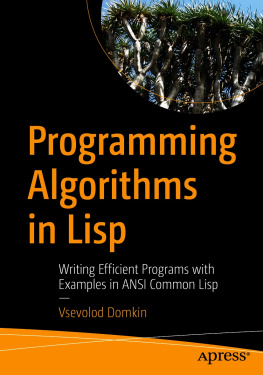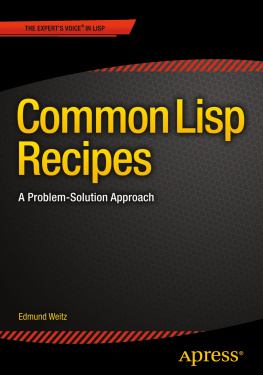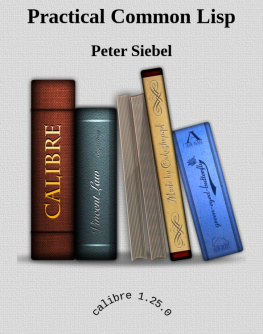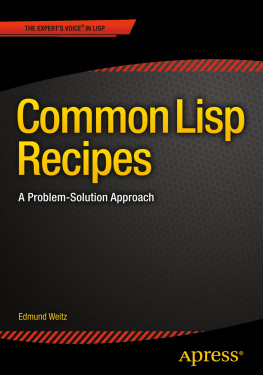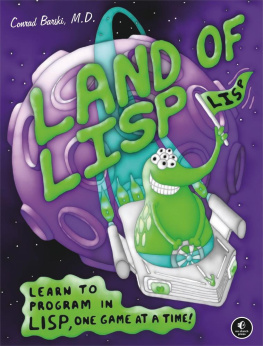Mark Watson - Loving Common Lisp, or the Savvy Programmer’s Secret Weapon
Here you can read online Mark Watson - Loving Common Lisp, or the Savvy Programmer’s Secret Weapon full text of the book (entire story) in english for free. Download pdf and epub, get meaning, cover and reviews about this ebook. year: 2013, publisher: leanpub.com, genre: Computer. Description of the work, (preface) as well as reviews are available. Best literature library LitArk.com created for fans of good reading and offers a wide selection of genres:
Romance novel
Science fiction
Adventure
Detective
Science
History
Home and family
Prose
Art
Politics
Computer
Non-fiction
Religion
Business
Children
Humor
Choose a favorite category and find really read worthwhile books. Enjoy immersion in the world of imagination, feel the emotions of the characters or learn something new for yourself, make an fascinating discovery.

- Book:Loving Common Lisp, or the Savvy Programmer’s Secret Weapon
- Author:
- Publisher:leanpub.com
- Genre:
- Year:2013
- Rating:3 / 5
- Favourites:Add to favourites
- Your mark:
- 60
- 1
- 2
- 3
- 4
- 5
Loving Common Lisp, or the Savvy Programmer’s Secret Weapon: summary, description and annotation
We offer to read an annotation, description, summary or preface (depends on what the author of the book "Loving Common Lisp, or the Savvy Programmer’s Secret Weapon" wrote himself). If you haven't found the necessary information about the book — write in the comments, we will try to find it.
Loving Common Lisp, or the Savvy Programmer’s Secret Weapon — read online for free the complete book (whole text) full work
Below is the text of the book, divided by pages. System saving the place of the last page read, allows you to conveniently read the book "Loving Common Lisp, or the Savvy Programmer’s Secret Weapon" online for free, without having to search again every time where you left off. Put a bookmark, and you can go to the page where you finished reading at any time.
Font size:
Interval:
Bookmark:

This book is for sale at http://leanpub.com/lovinglisp
This version was published on 2020-08-03

* * * * *
This is a Leanpub book. Leanpub empowers authors and publishers with the Lean Publishing process. Lean Publishing is the act of publishing an in-progress ebook using lightweight tools and many iterations to get reader feedback, pivot until you have the right book and build traction once you do.
* * * * *

This work is licensed under a Creative Commons Attribution-NonCommercial-NoDerivatives 4.0 International License
Copyright 2011-2020 Mark Watson. All rights reserved. This book may be shared using the Creative Commons share and share alike, no modifications, no commercial reuse license.
This eBook will be updated occasionally so please periodically check the leanpub.com web page for this book for updates.
This is the sixth edition released summer of 2020.
Please visit the authors website.
If you found a copy of this book on the web and find it of value then please consider buying a copy at leanpub.com/lovinglisp to support the author and fund work for future updates.
Two examples optionally use the CAPI user interface toolkit provided with LispWorks Common Lisp and work with the free personal edition. The first CAPI application is Knowledge Graph Navigator and the second CAPI example is Knowledge Graph Creator. Both of these examples build up utilities for working with Knowledge Graphs and the Semantic Web.
I expand the Plot Library chapter to generate either PNG graphics files or if you are using the free personal edition of LispWorks you can also direct plotting output to a new window in interactive programs.
I added a new chapter on using the py4cl library to embed Python libraries and application code into a Common Lisp system. I provide new examples for embedding spaCy and TensorFlow applications in Common Lisp applications. In earlier editions, I used a web services interface to wrap Python code using spaCy and TensorFlow. I am leaving that chapter intact, renaming it from Using Python Deep Learning Models In Common Lisp to Using Python Deep Learning Models In Common Lisp With a Web Services Interface. The new chapter for this edition is Using the PY4CL Library to Embed Python in Common Lisp.
There were two chapters added:
- A complete application for processing text to generate data for Knowledge Graphs (targeting the open source Neo4J graph database and also support RDF semantic web/linked data)
- A library for accessing the state of the art spaCy natural language processing (NLP) library and also a state of the art deep learning model. These models are implemented in thin Python wrappers that use Python libraries like spaCy, PyTorch, and TensorFlow. These examples replace a simple hybrid Java and Common Lisp example in previous editions.
I have added text and explanations as appropriate throughout the book and I removed the CouchDB examples.
I have made large changes to how the code for this book is packaged. I have reorganized the example code on GitHub by providing the examples as multiple Quicklisp libraries or applications. I now do this with all of my Common Lisp code and it makes it easier to write smaller libraries that can be composed into larger applications. In my own workflow, I also like to use Makefile targets to build standalone applications that can be run on other computers without installing Lisp development environments. Please follow the directions at the end of the Preface for configuring Quicklisp for easy builds and use of the example software for this book.
Why Common Lisp? Isnt Common Lisp an old language? Do many people still use Common Lisp?
I believe that using Lisp languages like Common Lisp, Clojure, Racket, and Scheme are all secret weapons useful in agile software development. An interactive development process and live production updates feel like a breath of fresh air if you have development on heavyweight like Java Enterprise Edition (JEE).
Yes, Common Lisp is an old language but with age comes stability and extremely good compiler technology. There is also a little inconsistency between different Common Lisp systems in such things as handling threads but with a little up front knowledge you can choose which Common Lisp systems will support your requirements.
I spent time writing this book to help you, dear reader. I release this book under the Creative Commons share and share alike, no modifications, no commercial reuse license and set the minimum purchase price to $5.00 in order to reach the most readers. Under this license you can share a PDF version of this book with your friends and coworkers and I encourage you to do so. If you found this book on the web (or it was given to you) and if it provides value to you then please consider doing one of the following to support my future writing efforts and also to support future updates to this book:
- Purchase a copy of this book leanpub.com/lovinglisp/ or any other of my leanpub books at https://leanpub.com/u/markwatson
- Hire me as a consultant
I enjoy writing and your support helps me write new editions and updates for my books and to develop new book projects. Thank you!
The fourth edition of this book was released in May 2017 and the major changes were:
- Added an example application KGCreator that processes text data to automatically generate data for Knowledge Graphs. This example application supports the Neo4J graph database as well as semantic web/linked data systems. The major changes were:
- Added a backpropagation neural network example
- Added a deep learning example using the Java based Armed Bear Common Lisp with the popular DeepLearning4j library
- Added a heuristic search example
- Added two machine learning examples (K-Means clustering and SVM classification) using the CLML library
- A few edits to the previous text
The third edition was released in October 2014. The major changes made in the 2014 edition are:
- I reworked the chapter CommonLispBasics.
- I added material to the chapter on using QuickLisp.
The second edition was released in 2013 and was derived from the version that I distributed on my web site and I moved production of the book to leanpub.com.
I would like to thank Jans Aasman for contributing as technical editor for the fourth edition of this book. Jans is CEO of Franz.com which sells Allegro Common Lisp as well as tools for semantic web and linked data applications.
I would like to thank the following people who made suggestions for improving previous editions of this book:
Sam Steingold, Andrew Philpot, Kenny Tilton, Mathew Villeneuve, Eli Draluk, Erik Winkels, Adam Shimali, and Paolo Amoroso.
Font size:
Interval:
Bookmark:
Similar books «Loving Common Lisp, or the Savvy Programmer’s Secret Weapon»
Look at similar books to Loving Common Lisp, or the Savvy Programmer’s Secret Weapon. We have selected literature similar in name and meaning in the hope of providing readers with more options to find new, interesting, not yet read works.
Discussion, reviews of the book Loving Common Lisp, or the Savvy Programmer’s Secret Weapon and just readers' own opinions. Leave your comments, write what you think about the work, its meaning or the main characters. Specify what exactly you liked and what you didn't like, and why you think so.


